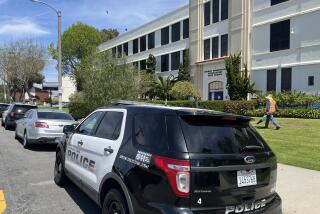Taking Lessons From the Sadness
- Share via
Perhaps Ryan Natale, all of 15, best captures how friends and family struggle to make sense of the murder of Deanna Maran.
“I just want to take it as a learning experience,” said Natale, a Santa Monica High School classmate who held Maran in his arms after she was stabbed by a 17-year-old girl at a crowded Westside party. How tragic, he said, that “God had to take someone so great to teach us all a lesson.”
For the record:
12:00 a.m. April 25, 2002 FOR THE RECORD
Los Angeles Times Thursday April 25, 2002 Home Edition Main News Part A Page 2 A2 Desk 2 inches; 64 words Type of Material: Correction
Concord High--A story in Tuesday’s California section implied that Katrina Sarkissian, who fatally stabbed a 15-year-old girl last fall, was once a full-time student at Concord High School in Santa Monica. Sarkissian, 17, took two summer courses at Concord in 1999 but was never a regular student. Such students must pass an interview for admittance and their academic records are scrutinized, according to Susan Packer Davis, Concord’s administrator.
Although Maran’s was one violent teen death among the many that occur each year in California, her killing has generated a remarkable amount of controversy and national media attention.
First, there was the girl-versus-girl aspect. Moreover, the killing occurred on a tree-lined street in an upscale neighborhood. Maran was known by those closest to her as LaLa, and she was famous for her prodigious appetite. So it was fitting that her relatives, friends and teachers gathered last week to celebrate her life with a feast--chow mein, steamed salmon with dill, satay, strawberries dipped in chocolate. It would have been her 16th birthday.
Dozens of admirers young and old crowded into the Maran family’s Ocean Park home to revel in memories of the brainy, fun-loving sophomore. The partygoers reminisced over scrapbooks and swapped tales about Maran’s dogged determination, wacky wit and penchant for treating friends’ refrigerators as her own.
A strapping 5-foot-6, 158-pound water polo and volleyball player, Maran was stabbed in the heart Nov. 17. The next day, Katrina Sarkissian, her killer, collapsed while being questioned at a West Los Angeles police station and died at UCLA Medical Center. An autopsy revealed that she had taken an overdose of antidepressant tablets.
Friends of Maran who went to the Saturday night party last November say the stabbing was so swift and unexpected that they had no chance to intervene. Others are tortured by thoughts that they could have stopped a tragedy, if only they had been there.
Questions--the need to take lessons from the tragedy--abound:
How did so many unchaperoned kids--from Santa Monica High as well as from some of the area’s best private schools--gravitate to the party that night? Why did some partygoers urge the girls on, cheering, “Fight! Fight!”? Why didn’t anyone try to stop it? Where were the adults?
“Everyone’s looking for a greater meaning in this,” said Harland W. Braun, an attorney representing a girl who some witnesses say had a role in the incident but has not been charged. “If it had happened in South-Central Los Angeles, nobody would be looking for a greater meaning.”
The fallout from the party continues. This month, Sarkissian’s younger half-sister, whose scuffle with Maran triggered the fight, was charged with one count of battery and one count of making a criminal threat. The battery charge relates to an allegation that she kicked Maran, said Sandi Gibbons, a spokeswoman for the Los Angeles County district attorney’s office.
The other charge involves a threat made on the Internet months after the party. The girl, who is 15, is to be arraigned Friday. As for Katrina Sarkissian, Deb Hof, a dean at a private school in Palo Alto, recalls a different girl from the one who has been vilified but whose death, she said, is also tragic.
“She was bright; she was a wonderful kid who had a lot going on in her life,” said Hof, who was a dean at Harvard-Westlake, where Sarkissian attended seventh and eighth grades. “I know she was struggling and unhappy, [but] there was a lot to like about her.”
Sarkissian, Hof recalled, “looked like a woman at 13 [and] got constant attention from every male on the planet.” Her father and mother were divorced, and her mother, Angelique, married ophthalmologist Matthew Bernstein, with whom she had another daughter. The Bernsteins later divorced as well.
In middle school, Sarkissian was a textbook case of a girl who needed adults to guide her and set boundaries, Hof said.
“Katrina was trying to figure out where she fit in,” she said.
Hof recalled that Sarkissian struggled during ninth grade at Harvard-Westlake, one of the region’s most rigorous private schools. “I think her academic light was extinguished by worries about boys, friends and her universe,” Hof said.
“Katrina just wasn’t a kid to back down, and then she would be in tears because nobody liked her,” Hof said. She withdrew from the school in early 1999 (although her death certificate inexplicably lists her “profession” as student and her “employer” as Harvard-Westlake) to seek a “smaller, more structured school.”
At some point, according to her stepfather, Sarkissian landed at Concord High School in Santa Monica. She left that private school as well and, he said, was home-schooled for the last eight months of her life.
Bernstein’s chief concern now, he said, is his 15-year-old daughter. She has received 20 death threats, he said, some of which have come to his office. Rattled by the calls, one of his employees quit.
Of Maran, he said: “She might have been a great kid, but that night she acted very unwisely and aggressively. As a result, Katrina’s dead and [my daughter] is still not out of the woods.”
Here is Natale’s account--corroborated by other witnesses--of the incident:
Sarkissian’s half-sister was horsing around, chasing one of Natale’s friends around the backyard. They repeatedly upset a flower pot.
Maran, known for being fearless, grabbed the girl by the shoulders, telling her to stop. “I don’t recall the exact words,” Natale said, “but she said something like, ‘Show respect for someone else’s house.’” The other girl told Maran not to touch her; they pushed each other and then began fighting.
The other girl was thrown off a short ledge and landed in a flower bed, still holding Maran’s hair. Some boys broke up the tussle. Maran began shouting “Samo! Samo!”--a nickname for Santa Monica High. It was clear that the other girl, not a Santa Monica High student, was humiliated. “She was dirty but not hurt. Her pride was hurt,” Natale said.
Then, Natale said, he overheard the girl on her cell phone: “Katrina, you’ve got to get here right now. Some bitch just pushed me down.”
About an hour later, as Maran was trying to find a ride home, Natale said, Sarkissian pulled up in a white sport utility vehicle and asked, “Who pushed my sister?” Maran raised her hand.
The girls argued for about five minutes and then, Natale recalled, Sarkissian rushed Maran, and the two pushed each other. One or two punches were thrown.
Sarkissian quickly ran away, and Maran stumbled backward. Another girl, he said, came in and grabbed Maran, pushing her to the ground and holding her down.
After a few seconds, that girl backed off. Sarkissian’s half-sister came up and kicked Maran’s midsection. By that time, Natale said, some kids were yelling “Fight! Fight! Hit her already.”
“No one even knew what happened,” he said. “Not a single witness saw a blade at any time.”
Indeed, no weapon was ever recovered. Authorities concluded that the weapon was a “punch knife,” in which the blade pops out between the user’s fingers.
Maran, wearing a dark blue sweatshirt and jeans, got up, stumbled and leaned against a tree, staring off into space. Natale, who at the time had a cast on his right wrist, tried to pick her up but “she was completely lifeless.” He then saw that his cast “was completely stained with blood.”
At that moment, he said, everybody panicked. When another student pulled up in his car to join the party, several kids piled Maran into the back seat. They sped off for Santa Monica Hospital, apparently unaware that UCLA Medical Center was blocks away.
Natale heard later that one boy in the car had his hand on Maran’s chest and felt her heart stop beating. She was declared dead just after midnight.
What, her friends have wondered since, can be learned from such a tragedy?
James Yoo, 15, who attended the party, said it taught him to be less eager to lash out at people who annoy him. “I’m just more cautious about fights,” he said. “I just let things go.”
For Lee Livingston, whose son Tim rode the bus with Maran to the party and then watched as she was mortally wounded, it has reminded him that parents need to set and enforce rules. But parenting teenagers, he said, involves leaps of faith.
“You pray to God they’re telling you the truth,” he said. “We have reiterated the rules. We keep bringing it up and telling him, ‘You’ve got to let us know where you are.’”
If this has been a grim lesson in growing up, Maran’s death has also shown teenagers that it’s possible to simultaneously mourn and celebrate a life. Witness the empty chair in the alto section of the Samohi Chorale.
Maran’s voice is no longer raised in song, but her picture hangs on the choral room bulletin board. In March, two choirs dedicated their performance of the Mozart Requiem to her. She had struggled with some of the passages, said choral director Christopher Rhodes, but she was “always very much the cheerleader, saying ‘Don’t give up.’”
At the birthday gathering, partygoers admired the shrine that Maran’s mother, Harriet, maintains in front of the house, with its crown of large plastic sunflowers. Not long ago, that shrine drew a visitor, Julie Freitas, who three years ago also lost a child when her son was murdered.
She has since become a friend, visiting once a week with muffins and conversation, seeking to help the Marans along a “long and pretty unbearable journey of grief.”
The party at the Maran home helped too. It was good, somehow, to see so many of Deanna’s friends--hugging, laughing and, of course, weeping.
More to Read
Sign up for Essential California
The most important California stories and recommendations in your inbox every morning.
You may occasionally receive promotional content from the Los Angeles Times.











